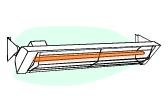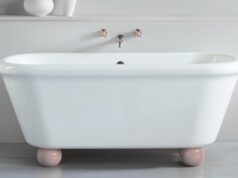
Radiant bar heaters (or strip heaters) produce a lot of heat very quickly, and are ideal for areas like bathrooms, where heat is required for short amounts of time.

These electric space heaters (which are also known as strip heaters) are commonly used in smaller rooms – particularly in bathrooms. They provide fast, furious radiant heat when it’s needed in a hurry. While they are common, they’re generally considered to be very inefficient and are only recommended for use for short periods, in small spaces, when heat is needed in a hurry.
How do radiant bar heaters work?
Electric bar heaters are very basic in the way they work. When they’re turned on, an electric current flows through a specially designed resistive element. The resistance causes electrical energy to be converted to heat energy, which is radiated out. This provides an instant and very intense heat, and these types of heaters normally feature guards that prevent direct contact with the heating element.
Radiant bar heaters typically also feature a metal reflector plate behind the element, which helps to control the direction in which heat is radiated.
Where should I use one?
Radiant bar heaters are particularly effective in smaller areas that need to be heated quickly – the most obvious and common place you’ll find these heaters is mounted on the wall in bathrooms, where they make getting out of the shower almost bearable during winter months. The fact that they produce radiant heat rather than convective heat makes them effective only in a small area as a space heater. Portable versions can also be used to heat a single person in a large room, but will only provide heat for the area they’re being used in.
How energy efficient are bar heaters?
These types of heaters are extremely inefficient, and using them for long periods of time can become quite expensive. For longer periods, you might want to consider using an electric panel heater instead.
|
Advantages
|
Disadvantages
|





